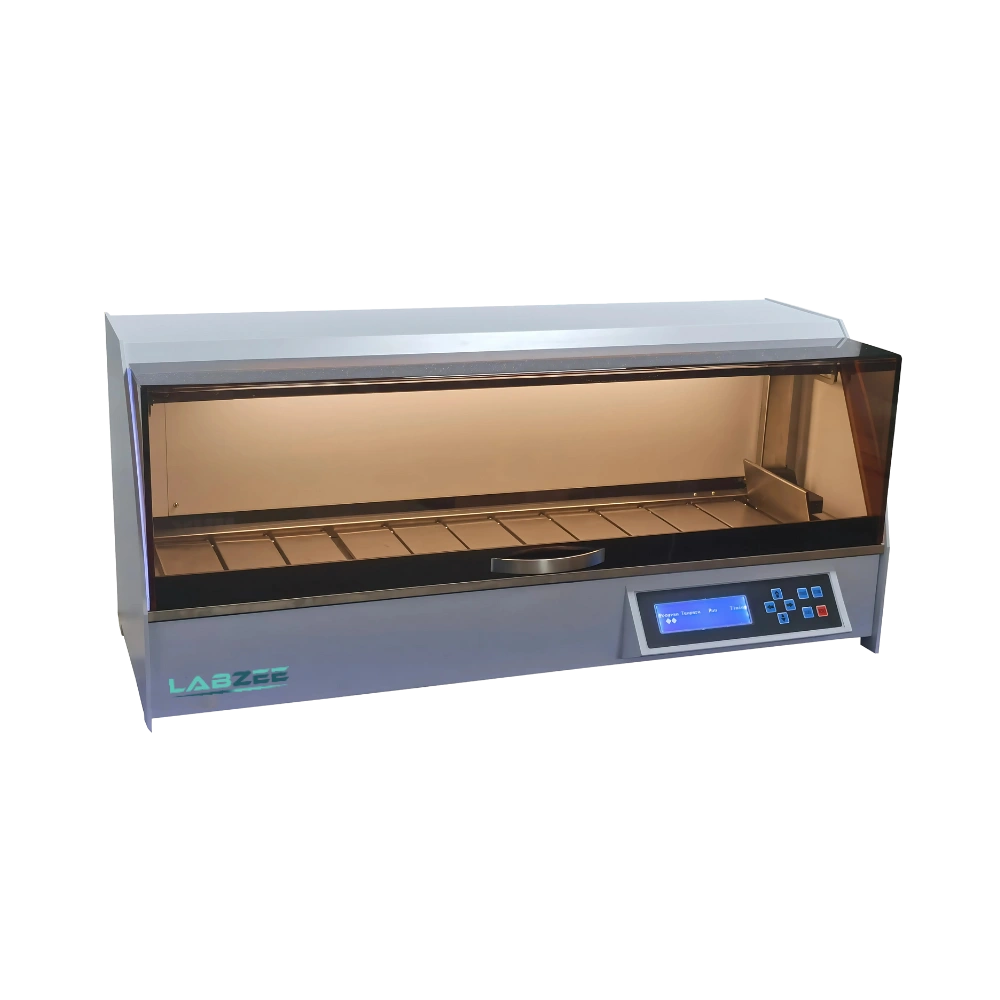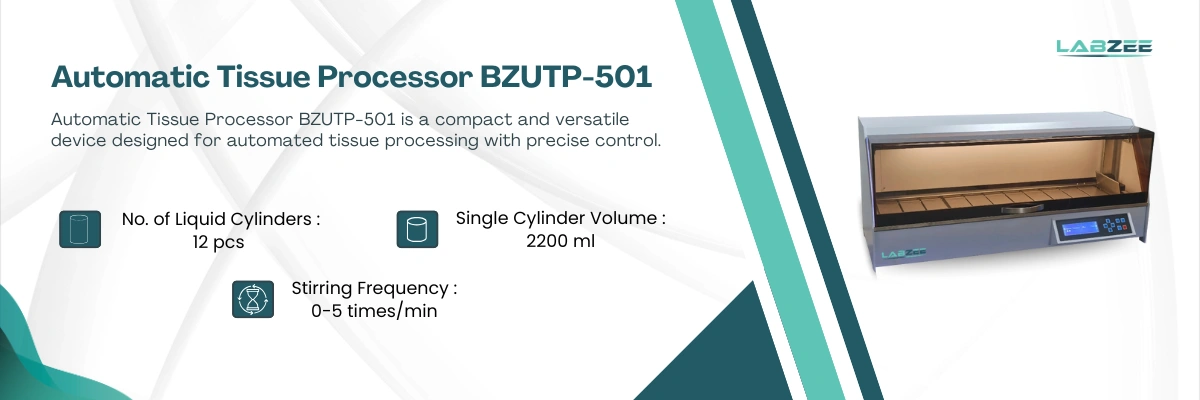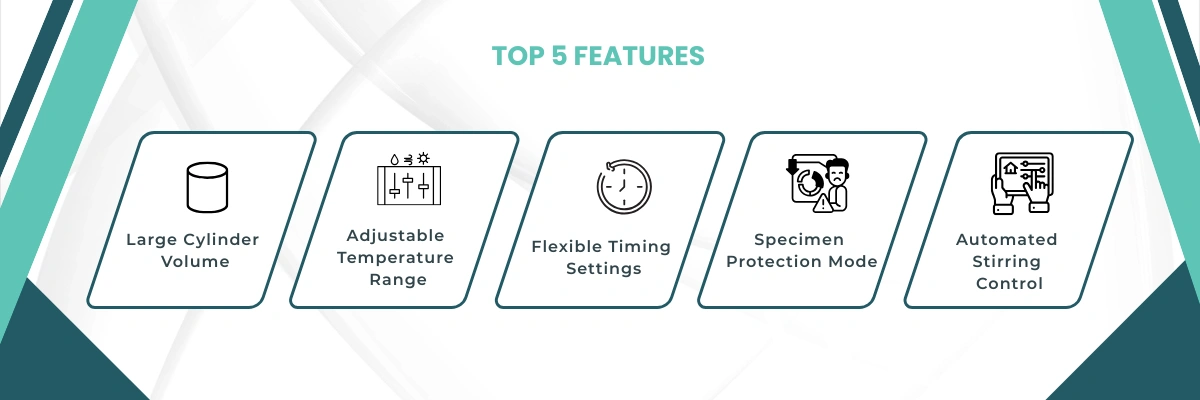
Automatic Tissue Processor BZUTP-501 is a compact and versatile device designed for automated tissue processing with precise control. This Tissue Processor includes 12 liquid cylinders, each with a volume of 2200 ml, and a specimen capacity of 125 per basket. It offers a fully customizable working time per cylinder and allows wide range of temperature settings to suit various tissue processing protocols. Its stirring frequency and cylinder start dwell time can be finely tuned, while a specialized protection position safeguards sensitive specimens. Our Automatic Tissue Processor BZUTP-501 is ideal for clinical labs, research institutions, histopathology centers, and diagnostic laboratories.
$4,543.00
| No. of Liquid Cylinders | 12 pcs (including 3 wax cylinders) |
| Single Cylinder Volume | 2200 ml |
| Specimen Capacity per Basket | 125 specimens |
| Working Time per Cylinder | Arbitrarily set within 0-24 hours |
| Temperature Setting Range | 0-99 °C (arbitrary setting) |
| Cylinder Start Dwell Time | 45-100 seconds |
| Organization Protection Position | Cylinder No. 7 |
| Stirring Frequency | 0-5 times/min |
| Power Consumption | ≤500 W |
| Power Supply | AC 220V ±10%, 50 Hz ±10% |
| Product Dimension | 1250 × 410 × 560 mm |
| Package Dimension | 1330 × 540 × 740 mm |
| Net Weight | 82 Kg |
| Gross Weight | 107 Kg |
| Packaging Type | Wooden Case |
Our Automatic Tissue Processor BZUTP-501 automates the dehydration and processing of biological tissues, streamlining workflow in histology and pathology labs. It is well suited for tissue embedding preparation, diagnostic sample processing, academic research, and clinical pathology applications. This device ensures reproducible and high-quality tissue sample preparation.
Frequently Asked Questions
1: What is the liquid cylinder capacity of the Automatic Tissue Processor BZUTP-501?
The Automatic Tissue Processor BZUTP-501 features 12 liquid cylinders, including 3 dedicated wax cylinders, each holding 2200 ml. This capacity supports extensive tissue processing cycles with minimal interruptions.
2: How many specimens can the Automatic Tissue Processor BZUTP-501 handle per basket?
It accommodates up to 125 specimens per basket, enabling efficient batch processing that improves laboratory throughput.
3: Are the working time and temperature adjustable on the Automatic Tissue Processor BZUTP-501?
Yes, the working time per cylinder is arbitrarily adjustable from 0 to 24 hours, and the temperature range can be set between 0 and 99°C, offering maximum flexibility for different tissue processing protocols.
4: What special features does the Automatic Tissue Processor BZUTP-501 include for specimen protection?
This processor includes a protection position specifically for Cylinder No. 7 to safeguard sensitive specimens during processing, along with automated stirring frequency control to ensure uniform treatment.
5: What are the electrical requirements and size specifications of the Automatic Tissue Processor BZUTP-501?
It operates on AC 220V ±10% with a frequency of 50 Hz ±10%, consumes up to 500 watts of power, and has compact dimensions that fit well in most laboratory environments.
6: When should an Automatic Tissue Processor be
preferred over manual methods? Automatic processors save time, reduce human error, and deliver consistent results. They are best used in labs with moderate to high sample volumes. They improve efficiency in routine histological workflows.
7: Can the processor be customized for specific tissue protocols?
Yes, Automatic Tissue Processors allow full customization of processing cycles. Parameters like duration, reagent type, and temperature can be adjusted. This flexibility supports various tissue types and lab standards.
8: Can it run unattended during overnight shifts?
Yes, these units are designed for safe, unattended operation with automated monitoring. Built-in alarms and safety shutdowns ensure reliability during long runs. Always verify settings before leaving the unit running.
9: When does the system need maintenance?
Basic cleaning should be done after each run to avoid residue buildup. Full maintenance depends on usage frequency and manufacturer guidelines. Regular upkeep ensures processing accuracy and equipment longevity.
10: Can different sample batches be processed on the same day?
Yes, multiple batches can be processed by programming new cycles after completion. Efficient scheduling helps maximize daily throughput. Ensure reagent levels and temperatures are properly maintained between runs.

